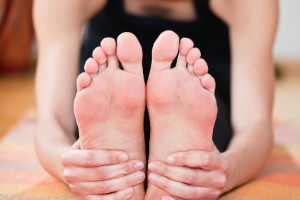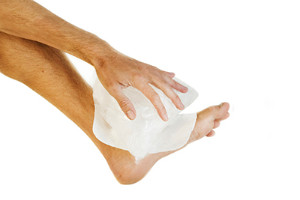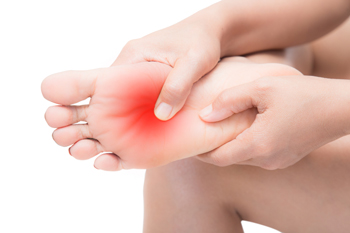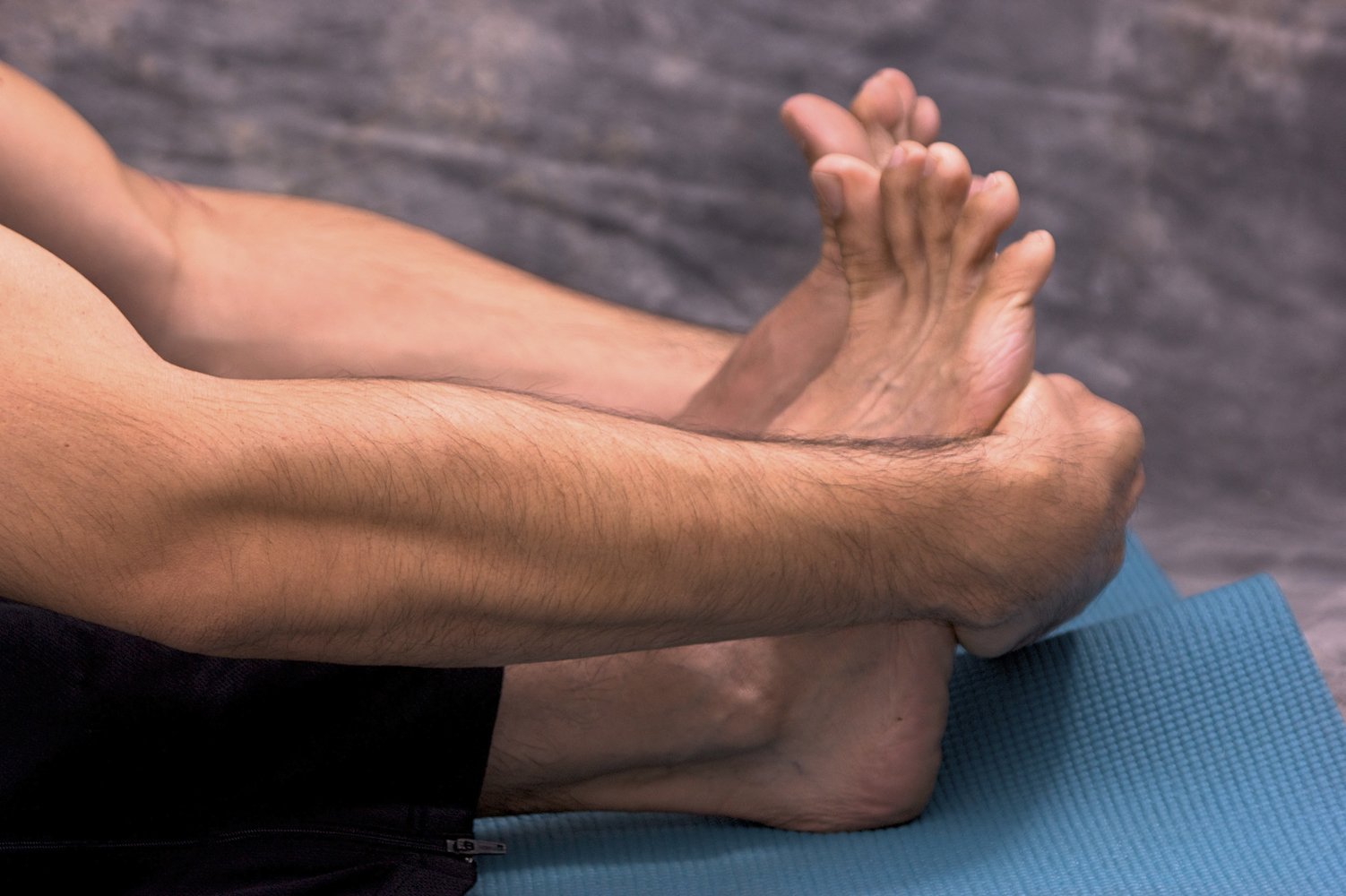NJ (908) 688-5577
NY (212) 737-2528
 Many people who enjoy the sport of running have realized the importance of properly stretching and preparing before engaging in running activities. This may help to prevent running injuries from occurring. Some people make the mistake of running too many miles before building up adequate strength, in addition to not getting enough rest in between runs. It is beneficial to keep a training log, which can help to track the amount of miles that are run and rest that is taken. When the proper running shoes are worn, the risk of injury may decrease. These include shoes that have ample cushioning and enough room for the toes move freely in. When stretching is practiced before and after each run, the muscles often remain strong, and this may aid in minimizing running injuries. If you would like additional information about how to prevent running injuries, it is suggested that you schedule a consultation with a podiatrist.
Many people who enjoy the sport of running have realized the importance of properly stretching and preparing before engaging in running activities. This may help to prevent running injuries from occurring. Some people make the mistake of running too many miles before building up adequate strength, in addition to not getting enough rest in between runs. It is beneficial to keep a training log, which can help to track the amount of miles that are run and rest that is taken. When the proper running shoes are worn, the risk of injury may decrease. These include shoes that have ample cushioning and enough room for the toes move freely in. When stretching is practiced before and after each run, the muscles often remain strong, and this may aid in minimizing running injuries. If you would like additional information about how to prevent running injuries, it is suggested that you schedule a consultation with a podiatrist.
Exercising your feet regularly with the proper foot wear is a great way to prevent injuries. If you have any concerns about your feet, contact Glenn Davison, DPM of Advanced Podiatry. Our doctor will treat your foot and ankle needs.
How to Prevent Running Injuries
Many common running injuries are caused by overuse and overtraining. When the back of the kneecap starts wearing out and starts causing pain in your knee, this is commonly referred to as runner’s knee. Runner’s knee is a decrease in strength in your quadriceps and can occur if you’re not wearing properly fitted or supporting shoes. To prevent runner’s knee, focusing on hip strengthening is a good idea, as well as strengthening your quads to keep the kneecaps aligned.
What Are Some Causes of Running Injuries?
- One cause of a common running injury is called iliotibial band syndrome.
- Plantar fasciitis is also another common injury.
- Stress fractures can occur from overtraining, lack of calcium, or even your running style.
Best Ways to Prevent Running Injuries
- Wear footwear that fits properly and suits your running needs.
- Running shoes are the only protective gear that runners have to safeguard them from injury.
- Make a training schedule. Adding strengthening exercises as well as regular stretching can help keep you strong and limber and can lessen the possibility of injuries.
- Stretching keeps muscles limber; this will help you gain better flexibility.
If you have any questions please feel free to contact our offices located in Union, NJ and New York . We offer the newest diagnostic and treatment technologies for all your foot and ankle needs.
 Many people will suffer from ankle pain at some point in their lives. There are different reasons why this type of pain occurs, and these may include fracturing or spraining your ankle. An eversion ankle sprain is considered to be uncommon, and affects the ligaments on the inside of the ankle. This happens when the ankle rolls inward. If the ligament or tendon tears and a piece of bone is intertwined, it is referred to as an avulsion fracture. If the cartilage that protects the ends of the bones becomes damaged, this is known as a osteochondral fracture. If you have sprained or broken your ankle, it is advised to consult with a podiatrist who can properly diagnose and treat ankle pain.
Many people will suffer from ankle pain at some point in their lives. There are different reasons why this type of pain occurs, and these may include fracturing or spraining your ankle. An eversion ankle sprain is considered to be uncommon, and affects the ligaments on the inside of the ankle. This happens when the ankle rolls inward. If the ligament or tendon tears and a piece of bone is intertwined, it is referred to as an avulsion fracture. If the cartilage that protects the ends of the bones becomes damaged, this is known as a osteochondral fracture. If you have sprained or broken your ankle, it is advised to consult with a podiatrist who can properly diagnose and treat ankle pain.
Ankle pain can have many different causes and the pain may potentially be serious. If you have ankle pain, consult with Glenn Davison, DPM from Advanced Podiatry. Our doctor will assess your condition and provide you with quality foot and ankle treatment.
Ankle pain is any condition that causes pain in the ankle. Due to the fact that the ankle consists of tendons, muscles, bones, and ligaments, ankle pain can come from a number of different conditions.
Causes
The most common causes of ankle pain include:
Symptoms
Symptoms of ankle injury vary based upon the condition. Pain may include general pain and discomfort, swelling, aching, redness, bruising, burning or stabbing sensations, and/or loss of sensation.
Diagnosis
Due to the wide variety of potential causes of ankle pain, podiatrists will utilize a number of different methods to properly diagnose ankle pain. This can include asking for personal and family medical histories and of any recent injuries. Further diagnosis may include sensation tests, a physical examination, and potentially x-rays or other imaging tests.
Treatment
Just as the range of causes varies widely, so do treatments. Some more common treatments are rest, ice packs, keeping pressure off the foot, orthotics and braces, medication for inflammation and pain, and surgery.
If you have any questions, please feel free to contact our offices located in Union, NJ and New York . We offer the newest diagnostic and treatment technologies for all your foot care needs.
The ankle joint is the point at which the bones of the leg and foot join. This joint is crucial because it is responsible for the foot’s mobility. Ankle pain is typically the result of inflammation from an injury to bones, joint space, cartilage, ligaments, tendons, or muscles in the area. Commonly associated symptoms with ankle pain are bruising, redness, numbness, stiffness, weakness, and tingling.
The most common causes of ankle pain are sprains and injuries. Ankle sprains are one of the most common musculoskeletal injuries. Sprains occur when the ligaments of the ankle become partially or completely torn due to sudden stretching. Sprains can occur on either the inner or outer sides of the ankle joint. Usually, these injuries occur when the ankle is twisted in an activity by stepping off an uneven surface. More specific causes include rheumatoid arthritis, gout, osteoarthritis, and Achilles tendonitis.
If you are experiencing ankle pain, you should consult with your podiatrist to choose the best method of care. Your doctor will conduct an examination of your ankle to determine the underlying cause of the pain.
 The ankle enables the foot to move up, down, and around. It is the part of the body that connects the leg and the foot, and mobility may become difficult if the ankle is injured. There are additional symptoms that can accompany ankle pain, including a tingling sensation, swelling, or bruising. These may be a result of existing medical conditions, which can include gout, rheumatoid arthritis, Achilles tendonitis, or a fall involving the ankle. If the swelling occurs on one side of the ankle, it may be from a sprain or strain. Additionally, pregnant women may experience swelling as a result of excess fluid that is present in the body, and this may lead to ankle pain. If you have ankle pain for any reason, it is suggested that you speak to a podiatrist who can properly treat your condition.
The ankle enables the foot to move up, down, and around. It is the part of the body that connects the leg and the foot, and mobility may become difficult if the ankle is injured. There are additional symptoms that can accompany ankle pain, including a tingling sensation, swelling, or bruising. These may be a result of existing medical conditions, which can include gout, rheumatoid arthritis, Achilles tendonitis, or a fall involving the ankle. If the swelling occurs on one side of the ankle, it may be from a sprain or strain. Additionally, pregnant women may experience swelling as a result of excess fluid that is present in the body, and this may lead to ankle pain. If you have ankle pain for any reason, it is suggested that you speak to a podiatrist who can properly treat your condition.
Ankle pain can be caused by a number of problems and may be potentially serious. If you have ankle pain, consult with Glenn Davison, DPM from Advanced Podiatry. Our doctor will assess your condition and provide you with quality foot and ankle treatment.
Ankle pain is any condition that causes pain in the ankle. Due to the fact that the ankle consists of tendons, muscles, bones, and ligaments, ankle pain can come from a number of different conditions.
Causes
The most common causes of ankle pain include:
Symptoms
Symptoms of ankle injury vary based upon the condition. Pain may include general pain and discomfort, swelling, aching, redness, bruising, burning or stabbing sensations, and/or loss of sensation.
Diagnosis
Due to the wide variety of potential causes of ankle pain, podiatrists will utilize a number of different methods to properly diagnose ankle pain. This can include asking for personal and family medical histories and of any recent injuries. Further diagnosis may include sensation tests, a physical examination, and potentially x-rays or other imaging tests.
Treatment
Just as the range of causes varies widely, so do treatments. Some more common treatments are rest, ice packs, keeping pressure off the foot, orthotics and braces, medication for inflammation and pain, and surgery.
If you have any questions, please feel free to contact our offices located in Union, NJ and New York . We offer the newest diagnostic and treatment technologies for all your foot care needs.
 People who enjoy the sport of running or jogging may be familiar with uncomfortable running injuries. The runner may be temporarily forced to cease running as a result of these injuries. Research has shown there are methods that can be implemented, which may prevent running injuries. These may include gradually increasing the miles and intensity, which may be accomplished with a training schedule. Additionally, wearing running shoes that fit correctly may help painful injuries from occurring, and performing frequent stretches may help the feet to remain limber and flexible. Many runners find it beneficial to maintain proper form and posture while running and practicing core exercises may help to strengthen the overall body. If you would like to learn about how to prevent running injuries, it is suggested that you speak to a podiatrist who can provide you with additional information.
People who enjoy the sport of running or jogging may be familiar with uncomfortable running injuries. The runner may be temporarily forced to cease running as a result of these injuries. Research has shown there are methods that can be implemented, which may prevent running injuries. These may include gradually increasing the miles and intensity, which may be accomplished with a training schedule. Additionally, wearing running shoes that fit correctly may help painful injuries from occurring, and performing frequent stretches may help the feet to remain limber and flexible. Many runners find it beneficial to maintain proper form and posture while running and practicing core exercises may help to strengthen the overall body. If you would like to learn about how to prevent running injuries, it is suggested that you speak to a podiatrist who can provide you with additional information.
All runners should take extra precaution when trying to avoid injury. If you have any concerns about your feet, contact Glenn Davison, DPM of Advanced Podiatry. Our doctor will treat your foot and ankle needs.
How to Prevent Running Injuries
There are a lot of mistakes a runner can make prior to a workout that can induce injury. A lot of athletes tend to overstretch before running, instead of saving those workouts for a post-run routine. Deep lunges and hand-to-toe hamstring pulls should be performed after a workout instead of during a warmup. Another common mistake is jumping into an intense routine before your body is physically prepared for it. You should try to ease your way into long-distance running instead of forcing yourself to rush into it.
More Tips for Preventing Injury
If you have any questions, please feel free to contact our offices located in Union, NJ and New York . We offer the newest diagnostic and treatment technologies for all your foot care needs.
 Research has shown patients who are overweight may develop heel pain. This may be a result of the excess pressure that is exerted on the heel, and may lead to the uncomfortable condition known as plantar fasciitis. Practicing consistent exercise is often recommended to lose additional weight, and this may be difficult to accomplish if chronic heel pain is present. There may be other types of heel pain that can develop as a result of being obese. These may include flat feet, bunions, or certain types of arthritis. If you are overweight, and have chronic foot pain, it is strongly suggested that you seek the counsel of a podiatrist who can properly assist you in treating any foot pain you may have.
Research has shown patients who are overweight may develop heel pain. This may be a result of the excess pressure that is exerted on the heel, and may lead to the uncomfortable condition known as plantar fasciitis. Practicing consistent exercise is often recommended to lose additional weight, and this may be difficult to accomplish if chronic heel pain is present. There may be other types of heel pain that can develop as a result of being obese. These may include flat feet, bunions, or certain types of arthritis. If you are overweight, and have chronic foot pain, it is strongly suggested that you seek the counsel of a podiatrist who can properly assist you in treating any foot pain you may have.
The more you weigh, the harder your feet must work to support your body. If you’re an obese individual and are concerned about your feet, contact Glenn Davison, DPM from Advanced Podiatry. Our doctor can provide the care you need to keep you pain-free and on your feet.
Obesity and Your Feet
People who are overweight are putting more pressure on their ankles, knees, and hips as well as their feet. This unfortunately can lead to variety of different issues.
Problems & Complications Stemming from Obesity
If you have any questions, please feel free to contact our offices located in Union, NJ and New York . We offer the newest diagnostic and treatment technologies for all your foot care needs.
Obesity is a common problem in American society. Approximately one third of the U.S. population is obese. Obesity is defined as a body mass index greater than 30. Obesity has the power to affect different aspects of the body, and one of the most common problems it causes is foot pain. There have been many studies that found a connection between an increased BMI and foot problems. A simple activity such as walking up a flight of stairs can increase pressure on the ankle by four to six times.
Being overweight causes the body to compensate for the extra weight by changing the way it moves. Consequently, people who struggle with obesity commonly have arch problems in their feet. Obesity causes the arch to break by stretching the ligaments and tendons that hold the bones in the foot together. When the arch lowers, the foot may eventually fall flat. Collapsed foot arches fail to provide adequate shock absorption which eventually leads to foot pain. Other conditions that may be caused by flat feet are pronation, plantar fasciitis, weak ankles, and shin splints.
Foot problems that are caused by obesity may be treated by wearing proper footwear. Proper shoes will allow your feet to have better circulation around the arch and ankle. Additionally, those with obesity often discover that typical heel pain remedies are not effective for them. They will find that their plantar fascia is easily injured, and it is often inflamed. The best way to treat this problem is to implement lifestyle changes. A few good ways to improve your diet are to reduce calories, fill up on fruits and veggies, and to limit sugars.
Custom foot orthotics can prevent foot problems if you’re carrying excess weight or are trying to lose weight. The purpose of orthotics is to provide shock absorption to decrease the amount of stress on the joints to prevent arthritis.
 There is a small canal between a bone in the ankle and the ligaments that stretch across the foot that is known as the tarsal tunnel. If this should become compressed and irritated, a condition that is known as tarsal tunnel syndrome may develop. A symptom of this condition may include a tingling sensation in the feet and toes, because this is the nerve that provides sensitivity to those areas of the foot. Additionally, many patients may experience a burning sensation in the sole of the foot. Some of the reasons that this condition can occur may include consistent motion which may come from participating in certain sporting activities. There may be existing medical conditions that may contribute to developing tarsal tunnel syndrome, and these may include flat feet, diabetes, or obesity. If you have any of these symptoms, it is suggested that you seek the counsel of a podiatrist who can properly treat tarsal tunnel syndrome.
There is a small canal between a bone in the ankle and the ligaments that stretch across the foot that is known as the tarsal tunnel. If this should become compressed and irritated, a condition that is known as tarsal tunnel syndrome may develop. A symptom of this condition may include a tingling sensation in the feet and toes, because this is the nerve that provides sensitivity to those areas of the foot. Additionally, many patients may experience a burning sensation in the sole of the foot. Some of the reasons that this condition can occur may include consistent motion which may come from participating in certain sporting activities. There may be existing medical conditions that may contribute to developing tarsal tunnel syndrome, and these may include flat feet, diabetes, or obesity. If you have any of these symptoms, it is suggested that you seek the counsel of a podiatrist who can properly treat tarsal tunnel syndrome.
Tarsal tunnel syndrome can be very uncomfortable to live with. If you are experiencing tarsal tunnel syndrome, contact Glenn Davison, DPM of Advanced Podiatry. Our doctor can provide the care you need to keep you pain-free and on your feet.
Tarsal Tunnel Syndrome
Tarsal tunnel syndrome, which can also be called tibial nerve dysfunction, is an uncommon condition of misfiring peripheral nerves in the foot. The tibial nerve is the peripheral nerve in the leg responsible for sensation and movement of the foot and calf muscles. In tarsal tunnel syndrome, the tibial nerve is damaged, causing problems with movement and feeling in the foot of the affected leg.
Common Cause of Tarsal Tunnel Syndrome
The Effects of Tarsal Tunnel Syndrome
A physical exam of the leg can help identify the presence of tarsal tunnel syndrome. Medical tests, such as a nerve biopsy, are also used to diagnose the condition. Patients may receive physical therapy and prescriptive medication. In extreme cases, some may require surgery.
If you have any questions please feel free to contact our offices located in Union, NJ and New York . We offer the newest diagnostic and treatment technologies for all your foot and ankle needs.
 Research has shown that feet may be an important way to determine the cause for many aches and pains that may be present in the body. When correct stretching techniques are incorporated into a daily routine, the general health of the body may be positively affected. An effective stretch for the arch of the foot is called a toe stretch. This may feel good if the toes become cramped in poorly fitting shoes. This is performed by interlacing the fingers between the toes, rotating the ankle, and repeating on the other side. If the arches in your foot feel tired, it may be beneficial to roll the bottom of your foot on a tennis ball, which may help to relax any tight muscles in the feet. Foot spasms may be avoided when the toes are frequently pointed and flexed. If you would like additional information about the benefits of stretching the feet, please consult with a podiatrist who can properly guide you.
Research has shown that feet may be an important way to determine the cause for many aches and pains that may be present in the body. When correct stretching techniques are incorporated into a daily routine, the general health of the body may be positively affected. An effective stretch for the arch of the foot is called a toe stretch. This may feel good if the toes become cramped in poorly fitting shoes. This is performed by interlacing the fingers between the toes, rotating the ankle, and repeating on the other side. If the arches in your foot feel tired, it may be beneficial to roll the bottom of your foot on a tennis ball, which may help to relax any tight muscles in the feet. Foot spasms may be avoided when the toes are frequently pointed and flexed. If you would like additional information about the benefits of stretching the feet, please consult with a podiatrist who can properly guide you.
Stretching the feet is a great way to prevent injuries. If you have any concerns with your feet consult with Glenn Davison, DPM from Advanced Podiatry. Our doctor will assess your condition and provide you with quality foot and ankle treatment.
Stretching the Feet
Being the backbone of the body, the feet carry your entire weight and can easily become overexerted, causing cramps and pain. As with any body part, stretching your feet can serve many benefits. From increasing flexibility to even providing some pain relief, be sure to give your feet a stretch from time to time. This is especially important for athletes or anyone performing aerobic exercises, but anyone experiencing foot pain or is on their feet constantly should also engage in this practice.
Great ways to stretch your feet:
Individuals who tend to their feet by regular stretching every day should be able to minimize foot pain and prevent new problems from arising.
If you have any questions, please feel free to contact our offices located in Union, NJ and New York . We offer the newest diagnostic and treatment technologies for all your foot care needs.
 There are many people who enjoy the sport or hobby of running and jogging, and may experience trauma to the foot or ankle as a result of this. A common running injury may often include Achilles tendonitis, and this will affect the Achilles tendon which is located behind the heel. It typically becomes injured if the calf muscles are not properly stretched before engaging in a running activity, and the inflammation may produce pain and discomfort. Additionally, many people injure their ankles by suddenly stepping off a curb which may cause the ankle to roll inward. This may cause the tendons, ligaments, and muscles to tear, and the pain that accompanies this may cause instability in the ankle. If you have endured any ankle or foot injury, it is advised to seek the counsel of a podiatrist who can properly treat the condition.
There are many people who enjoy the sport or hobby of running and jogging, and may experience trauma to the foot or ankle as a result of this. A common running injury may often include Achilles tendonitis, and this will affect the Achilles tendon which is located behind the heel. It typically becomes injured if the calf muscles are not properly stretched before engaging in a running activity, and the inflammation may produce pain and discomfort. Additionally, many people injure their ankles by suddenly stepping off a curb which may cause the ankle to roll inward. This may cause the tendons, ligaments, and muscles to tear, and the pain that accompanies this may cause instability in the ankle. If you have endured any ankle or foot injury, it is advised to seek the counsel of a podiatrist who can properly treat the condition.
Foot and ankle trauma is common among athletes and the elderly. If you have concerns that you may have experienced trauma to the foot and ankle, consult with Glenn Davison, DPM from Advanced Podiatry. Our doctor will assess your condition and provide you with quality foot and ankle treatment.
Foot and ankle trauma cover a range of injuries all over the foot; common injuries include:
Symptoms
Symptoms of foot and ankle injuries vary depending on the injury, but more common ones include:
Diagnosis
To properly diagnose the exact type of injury, podiatrists will conduct a number of different tests. Some of these include sensation and visual tests, X-rays, and MRIs. Medical and family histories will also be taken into account.
Treatment
Once the injury has been diagnosed, the podiatrist can than offer the best treatment options for you. In less severe cases, rest and keeping pressure off the foot may be all that’s necessary. Orthotics, such as a specially made shoes, or immobilization devices, like splints or casts, may be deemed necessary. Finally, if the injury is severe enough, surgery may be necessary.
If you have any questions, please feel free to contact our offices located in Union, NJ and New York . We offer the newest diagnostic and treatment technologies for all your foot care needs.